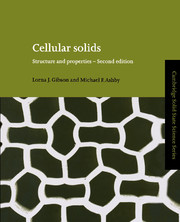Book contents
- Frontmatter
- Contents
- Preface to the second edition
- Preface to the first edition
- Units and conversion tables
- Chapter 1 Introduction
- Chapter 2 The structure of cellular solids
- Chapter 3 Material properties
- Chapter 4 The mechanics of honeycombs
- Chapter 5 The mechanics of foams: basic results
- Chapter 6 The mechanics of foams: refinements
- Chapter 7 Thermal, electrical and acoustic properties of foams
- Chapter 8 Energy absorption in cellular materials
- Chapter 9 The design of sandwich panels with foam cores
- Chapter 10 Wood
- Chapter 11 Cancellous bone
- Chapter 12 Cork
- Chapter 13 Sources, suppliers and property data
- Appendix: The linear-elasticity of anisotropic cellular solids
- Index
- References
Chapter 1 - Introduction
Published online by Cambridge University Press: 05 August 2014
- Frontmatter
- Contents
- Preface to the second edition
- Preface to the first edition
- Units and conversion tables
- Chapter 1 Introduction
- Chapter 2 The structure of cellular solids
- Chapter 3 Material properties
- Chapter 4 The mechanics of honeycombs
- Chapter 5 The mechanics of foams: basic results
- Chapter 6 The mechanics of foams: refinements
- Chapter 7 Thermal, electrical and acoustic properties of foams
- Chapter 8 Energy absorption in cellular materials
- Chapter 9 The design of sandwich panels with foam cores
- Chapter 10 Wood
- Chapter 11 Cancellous bone
- Chapter 12 Cork
- Chapter 13 Sources, suppliers and property data
- Appendix: The linear-elasticity of anisotropic cellular solids
- Index
- References
Summary
Introduction and synopsis
The word ‘cell’ derives from the Latin cella: a small compartment, an enclosed space. Our interest is in clusters of cells – to the Romans, cellarium, to us (less elegantly) cellular solids. By this we mean an assembly of cells with solid edges or faces, packed together so that they fill space. Such materials are common in nature: wood, cork, sponge and coral are examples (cellulose is from the Latin diminutive cellula: full of little cells).
Man has made use of these natural cellular materials for centuries: the pyramids of Egypt have yielded wooden artefacts at least 5000 years old, and cork was used for bungs in wine bottles in Roman times (Horace, 27 BC). More recently man has made his own cellular solids. At the simplest level there are the honeycomb-like materials, made up of parallel, prismatic cells, which are used for lightweight structural components. More familiar are the polymeric foams used in everything from disposable coffee cups to the crash padding of an aircraft cockpit. Techniques now exist for foaming not only polymers, but metals, ceramics and glasses as well. These newer foams are increasingly used structurally – for insulation, as cushioning, and in systems for absorbing the kinetic energy from impacts. Their uses exploit the unique combination of properties offered by cellular solids, properties which, ultimately, derive from the cellular structure.
- Type
- Chapter
- Information
- Cellular SolidsStructure and Properties, pp. 1 - 14Publisher: Cambridge University PressPrint publication year: 1997
References
- 21
- Cited by



